Table of Contents
Lifestyle Desk, Delhi Magazine: The bathroom is rarely associated with plants. However, bathroom plants are a fantastic idea that you should consider. The interior becomes more comfortable and filled with positive energy that enriches you every day. In addition to beauty, plants can create certain inconveniences. To prevent this from happening, they need to be skillfully placed.
These are the best plants most suitable for your bathroom

Bathroom plants are also a great idea for an unusual interior design. By placing plants on every free surface, you can turn your bathroom into a real jungle. In addition, you can place one unusual plant as a sophisticated decor element. No matter what you choose, bathroom plants will amaze everyone who visits you.
Fern (Nephrolepis)
One of the most spectacular indoor plants. But for a fern, it can be difficult to find a suitable place in the apartment. Problems are usually associated with the heating season and summer heat: nephrolepis does not tolerate too high temperatures and dry air. That’s why fern is considered the best plant for bathroom.

These prehistoric plants love the shady, moist forest, so they will love the atmosphere of the bathroom. Nephrolepis can be planted in a hanging planter, then it will elegantly cascade down.

Aspidistra
A “convenient” plant, because it requires almost no care. It will be necessary to water it in the bathroom once a week, and once a month it will be necessary to take it out into the daylight to “walk”.


Lucky Bambu
Bambu grows well in a humid climate, but without light it will be hard for her. Sander should be illuminated with fitolamps or placed closer to the light (for example, on a hill, closer to the ceiling chandelier).

This Bathroom plant grows in any light and even without soil. The bamboo root must be placed in a container filled with pebbles a few centimeters, and half filled with water – and that’s it, the green pet is ready! It is only necessary to monitor the water level, periodically adding it, so that the liquid always fills half the pot.
Orchis
Flowers for the bathroom, which will decorate it beautifully, are orchids (Orchis). Plants form leathery, thick leaves, collected at the base in a rosette. From it grows an ear of multi-colored flowers. Orchids are an unusual and beautiful interior decoration.

Orchid Plants should be planted in loose, permeable soil. Most often, peat and bark are chosen for this purpose. Orchids should only be watered when the substrate is completely dry. Orchids love high humidity, so the bathroom is a good place to grow them. Orchids don’t like too much sun, with extra lighting turned on, a bathroom would be a good choice.
Indoor Ivy
Indoor Ivy is a classic species plant, but it is ideal for growing in a bathroom because it does not require a lot of light and also needs little water. Do this when you feel dry earth when you touch it.

Tillandsia
The intriguing name Tillandsia includes about 500 plant species. They are more commonly known as air plants as they do not require soil to grow. These are epiphytes that receive the necessary nutrients from the air.
Tillandsia is ideal for those who love unusual and unexpected solutions. A plant that does not require any care, quickly adapts to conditions and is unpretentious in cultivation. It also looks original, and its flowers look incredibly exotic.

They are native to the rainforests of South America and can also be found in deserts, mountain peaks and wetlands. Plants can grow in the ground or on trees as epiphytes.

Depending on the species, the scythe has silvery or green, grooved, downward-curving leaves that are arranged in a rosette. The plant produces delicate, tubular, purple flowers. The spit has a weak root system.

When growing, it is important to ensure constant access of air to the roots.
In the pot, it is necessary to provide a temperature of at least 20 degrees Celsius and high humidity – the bathroom is ideal for this. They are planted in pots filled with peat and moss, or on bark, but since the plant is able to extract all the necessary nutrients from the air, it can be grown without a pot. You can find braids placed in glass bowls and on coasters. Plants love diffused light and therefore are not suitable for windowless bathrooms. You can water the bushes by pouring water directly into the rosette formed by the leaves, or by spraying them.
Pothos
Pothos ( Epipremnum aureum ) and ribbons ( Chlorophytum comosum )
“They are the most classic, but also the ones that work best . They do well in shady and humid places . In addition, they need little watering: just do it when the soil feels dry to the touch.”
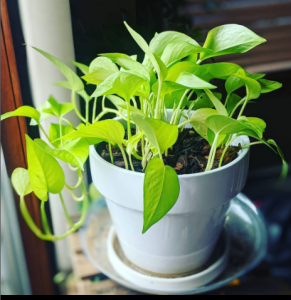
Dieffenbachia
The plant is known for absorbing toxic substances, which is why it is often grown in cities with poor environmental conditions. Dieffenbachia juice is poisonous: when it comes into contact with the skin, it causes swelling and chemical burns, and if swallowed, there will be paralysis of the larynx. So the plant should not be kept at home where pets or children live. It is necessary to work with it only in gloves.

Chlorophytum
Another natural air purifier and disinfectant. It kills up to 80% of pathogenic bacteria, absorbs carbon monoxide, ammonia, nitrogen, benzene and acetone. Chlorophytum crested is an unpretentious species, and will easily survive in a bathroom.

Zamioculcas Zamiifolia
If you don’t have time to take care of plants and want to have a plant in your bathroom that will effortlessly look good? The ZZ plant (Zamioculcas zamiifolia) is your best bet. This plant is called the “steel plant”, and for good reason – zamiokulkas is really hard to kill, and it looks great even when neglected.

Snake Plant
Also known as ‘snake plant’ or ‘serpent plant’, it is a plant that, in addition to growing without problem in these conditions of low light and high humidity, helps to purify the air . Its rigid green and yellow leaves are a sight for your bathroom.

Spathiphyllum
He loves moisture on the leaves, so he will be fine in the bathroom, but additional lighting will also come in handy for him – it is better to put it under a phytolamp.

Dwarf Golden Hahnii Sansevieria
Purifies the air of toxins that exude plastic and carbon monoxide. An unpretentious plant that will look good both under the sink and on the cabinet or on the closet.

Monstera
A tropical plant that loves moisture and is not picky about light. It looks great on the floor, as it is very large. For a small bathroom, this plant alone will be enough.

Philodendron Selloum
Philodendron Selloum generally loves the sun, but not its direct rays. So it is better to put it in the light. The base of the plant should be slightly damp at all times, but not too much. The substrate may dry out slightly between waterings.

Aloe vera
This plant is known as a disinfectant. That is why it is so good to keep it in an unventilated room: it will clean it. Aloe is unpretentious, it can be watered rarely (it takes moisture from the air).
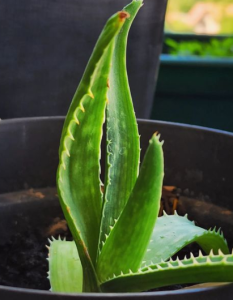
Green Alocasia
Green alocasia fits perfectly in both elegant and minimalist bathrooms. There are many varieties on the horticultural market, such as black velvet alocasia with brightly veined dark green leaves, or dragonscale alocasia with intriguing texture and color.

Chamaedora
Chamaedora elegans Loves moderately bright light and should not be kept near a window. Grows well when the soil is constantly slightly damp. The minimum temperature in winter is 10-13 °C.

Asplenium Nidus
Asplenium Nidus grows well in places with diffused light. For uniform growth, the plant in the pot should be regularly turned towards the light source. Leaves do not like spraying. It also helps in removing indoor carbon dioxide and formaldehyde.

Peperomia
Hundreds of different varieties can be found of this small plant, which does not need much light, with different leaf shapes and tones. Its compact size makes it ideal for small spaces and a fabulous option for decorating a small bathroom . It will suffice to water it once once a week.’

Selection of plants for the bathroom
The best options for bathrooms will be flowers, the natural habitat of which is the subtropics. Such plants can develop quickly and without problems in rooms with low light and high humidity.
In order to choose the right room “resident” for the bathroom, one should take into account the features of caring for him, as well as his need for:
- Sunlight;
- Moisture;
- Top dressing.
No light-loving flower will grow in a windowless room, just as a plant that does not require frequent watering and spraying will die in a damp room.
What plant varieties are best suited for the bathroom?
Ferns, palm trees: dieffenbachia, ficus, hovea, graceful hamedorea, uzambar violet (saintpaulia) are best suited in Bathroom.
Why put plants in the bathroom?
First, plants in the bathroom make it more beautiful. A pleasant combination of greenery and flowers decorates the bathroom and makes it cozy.
Secondly, bathroom plants absorb carbon dioxide, improve air quality, purify enclosed bathroom space, and help prevent mold.
Thirdly, the green color is calming, and the bathroom is also a place of relaxation.
Types Plants that are good for the window in a bathroom
The following houseplants are suitable for bathrooms with a window:
- Decembrist
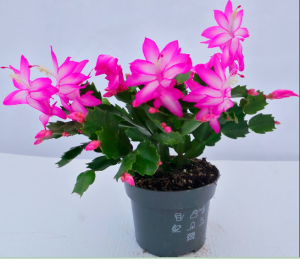
- Fern

- Orchid and Moth orchids

Orchid plant in bathroom window 
Moth orchids - Spathiphyllum

- Dracaena ”Lucky bamboo”

- Yucca

- Croton

- Coconut palm
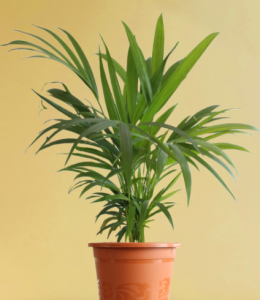
- Chamaedorea Mini Palm Tree
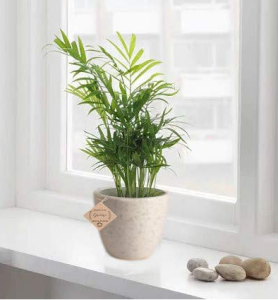
Therefore, it is very important to provide them with the right amount of light. Below we consider the basic rules for caring for them in a bathroom with and without a window.
Bathroom plants with a window require the following care rules:
- If there is a window sill under the bathroom window where you can put a plant pot, put them there, as the sun’s rays streaming through the window are the best source of light for them.
- Ventilate the bathroom regularly by opening a window.
- Water moderately. To avoid moisture stagnation, check the soil for moisture before watering. Water if the ground is dry.
- Transplant and feed in the same way as other houseplants.
- In winter, they do not need additional feeding.
Where to put plants in bathroom
- Place flowerpots on flat surfaces.
- Ampelous varieties can be placed on the walls, so they will not interfere with the use of the bathroom or furniture.
- It is not recommended to place flowerpots near a washstand, showers for two main reasons: the first – they can be touched by accident, dumped on the floor, the second – not all varieties like direct splashes on the leaves, base or stem.
- You should also not place flowerpots near heating radiators above the window; feed with granular fertilizers.

